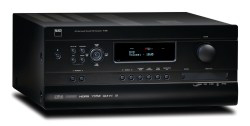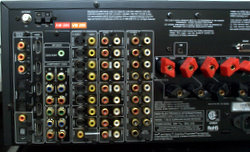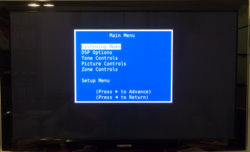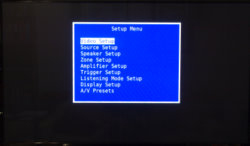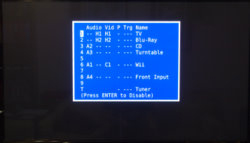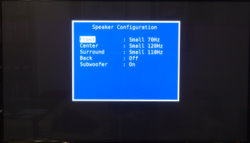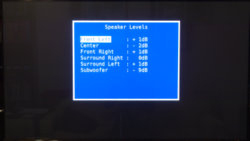Introduction
Most stereo and home theater enthusiasts know NAD, and can almost certainly pick out a piece of NAD gear without seeing the label from it’s distinctive, slate gray color scheme. While most people probably know NAD more for their CD players and integrated amplifiers, they have a whole line of home theater equipment, from receivers to processors, Blu-ray players and multi-channel amplifiers. Recently, NAD came out with a whole new line of receivers and processors featuring their Modular Design Construction. I think everyone is well aware of how fast things like HDMI are changing, and how people can become paralyzed before buying something, worried that a new revision of HDMI will out-date it before you even bring it home. By placing the inputs and outputs, as well as the processing hardware for the inputs, on upgradable cards, NAD hopes to have a receiver that will update as needed for the end user. I took a look at their top-of-the-line T785 receiver to see how this worked.
Specifications
- Design: 7.1 A/V Receiver
- Codecs: All, Including Dolby TrueHD and DTS-HD Master Audio
- Power Output: 7 x 120 Watts RMS into 8 Ohms
- THD+N: 0.08%
- Video Inputs: 6 Composite and S-Video (1 on Front), 3 Component, 4 HDM
- Video Outputs: 4 Composite (1 for Zone 2), 3 S-Video, 1 Component, 1 HDMI
- Audio Inputs: 7 RCA L/R (1 on Front), 1 7.1 RCA input, 3 Coaxial Digital, 3 Toslink Optical
- Audio Outputs: 4 RCA L/R (1 for Zone 2), 1 7.2 RCA Pre-out, 1 Coaxial Digital, 1 Toslink Optical
- Dimensions: 7.5″ H x 17.1″ W x 17″ D
- Weight: 45.9 Pounds
- MSRP: 3,999 USA
- NAD
Design
As I mentioned, the T785 has the AV inputs and outputs on removable cards to allow you to upgrade in the future. There is space for five cards in the system, and mine came outfitted with an HDMI card (containing the VM200 HDMI module with 4 HDMI inputs, 1 output and a Sigma Designs VXP scaler for video, and the AM200 audio module with 3 coaxial and 3 optical inputs, 1 optical and 1 coaxial output, and Audyssey MultEQ), a component video board (3 inputs, 1 output), a standard definition video board (5 composite and S-video inputs, 4 outputs including a second zone), an analog audio board (5 stereo pair inputs, 4 outputs including a second zone), and a multichannel audio board (7.1 RCA input, 7.2 RCA audio output). As these are replaceable, when HDMI 1.5 (for a future standard) is released, you should be able to upgrade your HDMI board with a new board for that standard, or in my case I would replace the component video board with another HDMI board, as I have no use for component in my system anymore.
The T785 features a 7 x 120 watts per channel amplifier that is powered by Twin Holmgren Toroidal power supplies with one dedicated to the front L/R channels, as well as 3 IR and 12V triggers, and an RS-232 port for custom installers. This power rating might sound low compared to other receivers, but the massive power supply that NAD has built into this unit shows that NAD is giving you a true measure of the output power of this receiver, not just what it was do with only 1 or 2 channels driven. All of the triggers enable the T785 to act as the brains for any home theater setup, no matter how complex it might be. The speaker binding posts accept banana plugs or bare wire, but not spades, and instead of the standard round covers for inserting bare wire, it features angled twist-down’s that I found much easier to get a very tight connection with. The spacing between them is a little tight, as it is with most receivers these days, but I wish more companies would use this method for bare wire.
The T785 is built like a tank compared to your regular receiver. It weighs far more than any receiver that I’ve used, and as you can see in the image, there are those massive toroidal power supplies inside to make sure that your speakers will not lack power during dynamic passages in music or films. The row of fans on the bottom worried me a little bit, as the small size could lead to a high pitched whine when they are running, but the only time I noticed the noise at all was when everything else was turned off in the room and the receiver was left running. During music or movies, no matter how quiet the passage, they never made themselves heard and took me out of the moment, and I never had any issues with the amp overheating either.
Setup
As I mentioned, the T785 has a twin toroidal transformers inside of it, which causes the left of the receiver to weigh far more than you would expect a receiver to weigh. Once I maneuvered it into my rack and hooked up all of my components, I began by setting up my inputs. Unlike most receivers, where inputs are labeled as DVD, Cable/Satellite, CD, and so on, the NAD just labels the inputs as Input 1, Input 2, Input 3, and so on, and then lets you create a custom label for it once you have set it up. For each input you set a video source (component, composite, HDMI), a digital audio source, an analog audio source, a name, gain (for level matching across inputs), an A/V Preset (covered later in this review), and triggers. For HDMI devices this is fairly simple, and you will probably use the same HDMI input for everything and skip all of the analog choices.
There is also a table mode that you can use to set this up. While it looks pretty busy and complex at first, once you figure it out you can set up the whole system very quick this way, and come back to easily make changes later. The only issue I had when setting this up was that the input scheme for the remote is not what you would expect. You don’t use the OK button and the arrows in the normal way most would assume, so I often found myself making mistakes when trying to input a value. I understand why NAD did it this way, but I wish they stuck with a more conventional scheme, even if you can’t do it as quickly once you learn it.
The AV input Presets that I mentioned above allow you to completely customize your sound and video settings on a per-input basis. Although your initial setup can take a bit longer to do, in the end it is worth it. For example, if I want to always get 24p output from my Blu-ray player and send that to my TV, but for my TiVo I want everything to be converted to 60p and sent over, I can setup two different AV presets that will handle those variations and assign them to the different inputs. Additionally, if I want to run a speaker setup with a crossover for my fronts, center, and surrounds for movies, but for multichannel music I want to have a new preset that runs the fronts in full range with no crossover, I can set that up as well. You can configure up to 5 different presets and assign them to inputs, or select them from the remote, so you don’t need to adjust anything in the menus if you want different profiles for different types of material.
Once everything was configured, I ran through Audyssey setup, which runs just like any Audyssey setup will. It properly detected my speaker distances and was close on the crossovers (a little high, but I’d rather it be conservative than miss some mid-bass since it set the crossover too low), and it offered me the choice of Audyssey curves. NAD also has their own custom Audyssey curve, which was developed by Paul Barton at their sister company PSB Speakers and approved for their exclusive use by Audyssey. The NAD curve setting seems to have a bit more bass and a bit less high frequency response in comparison to the standard Audyssey curve when I listened to it. I often lean towards the flat curve from Audyssey, as I have a bit of a bass hump in my room response and that can help to tame it down, but I liked the NAD curve as it didn’t have too much bass, but also helped to keep the high end from being too harsh or fatiguing. Of course, it’s easy for you to listen to the different curves and make your own choice, which is what I’d always recommend.
In Use

Given the design and construction of the T785, I had high hopes for how it would perform in my system. I started off with some two channel audio, using the analog inputs to get an idea for how it performed strictly as an integrated amp. The recent Mobile Fidelity remastering of Beck’s Sea Change album has become the CD I turn to first, as it’s very open and transparent and sounds as detailed as I think a standard CD can sound. I started out listening with Audyssey engaged and was treated to a very wide and deep soundstage, but things were a little muddled. Instruments and vocals seemed to be located in a general area of the stage and not anchored to a point, and the detail that I often hear wasn’t quite there. I switched over to the Analog Bypass listening mode instead of stereo, and found that it made a world of difference. This bypasses all internal DSP functions, A-D conversions, and speaker settings (so you are running full range) so it’s truly acting as a straight amplifier and nothing else. In this mode, the soundstage wasn’t quite as wide as with Audyssey, but it was far more precise and clear. Vocals and instruments were anchored into place as if you were listening to them record in a studio and all the detail in the recording came out. I think this is mostly a function of Audyssey, which is designed to give the best possible sound to a number of listeners over a larger seating area as well as correct for room issues, but for when I listened to music by myself that might not be as desirable. The AV presets let me keep my analog inputs in Analog Bypass mode, which sounded the best to me.

Though I don’t use Audyssey for my two channel listening, as soon as I go back to multichannel I always have it engaged. I fired up what has become my new benchmark for pushing a receiver or amplifier, the Blu-ray release of Fight Club. Where amplifiers with poor power supplies struggle is when going from a quiet sequence to a loud, dynamic sequence and they can’t provide the large amounts of power that speakers might need in a short period of time. A good scene for testing this out is the mid-air plane collision scene, where you go from a quiet airplane cabin, to having a mid-air crash and all the noise and explosions that result from it. It’s an aggressive mix that uses all the channels and asks a lot of your amplifier. When presented with this challenge, and with the volume cranked up, and T785 came through with flying colors. It sounded just like I was in the cabin of that airplane, with no clipping or compressed dynamics, even at a volume level far above what I would normally listen at.
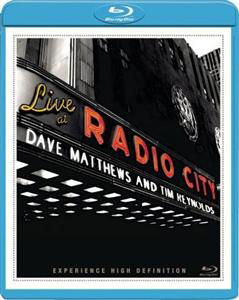
Moving onto multichannel music, I went back to the Blu-ray of Dave Matthews and Tim Reynolds at Radio City Music Hall. Most people have watched this on Blu-ray or own it which makes it a good disc to reference, and it just sounds fantastic. Listening once again on the T785 all of those little details in the recording came through. The sound of Tim Reynolds picking at his guitar, the metallic ringing that you would get from an individual note, all of it was there. After listening for a while, I just stopped writing notes and sat back to enjoy the rest of the concert as it had been a while since it sounded that good on my system.
One feature that people really want in their receiver now is a video processor, as everyone is moving to a 1080p display and since the scaler in the display is often lacking, they count on the receiver to pick up the slack. The Sigma Designs VXP that is built into the HDMI board of the T785 is one of the best solutions out there, used in many other high end products like the Lumagen Radiance XD and Anthem’s D2v reference preamp. The T785 might be the least expensive solution out there with a Sigma Designs VXP, but they still get the performance out of it. Most of my material now is HD and so I doubted how much the scaler would help, but the area that I actually appreciated it the most was when using my TiVo HD, which I didn’t expect.
I run my TiVo at native rate output, as many people do with their cable box or DVR, since I want to have it processed as little as possible. One side effect of this is that when I change channels the display and the box need to re-handshake over HDMI every single time, and it takes a few seconds just to change a channel. With the T785 set to 1080p60 output for the TiVo input, the display never lost a handshake when changing stations and it took only a second to do so. This probably seems like a very picky thing, but it made switching between channels (like with sporting events) much quicker than before, and just made watching TV more enjoyable. It also did a fantastic job scaling the content by not introducing any artifacts that I could see, and doing a great job passing the benchmark tests that I would throw at it from the Spears & Munsil and Marvell test discs.
Finally, as some people are interested, the FM tuner worked very well for me picking up the local NPR and ESPN radio stations, which some receivers have had trouble with in the past. The one quibble I had with the VXP is that it won’t pass Blacker-than-Black and Whiter-than-White information, which is useful in calibrating a display. However, NAD feels that the display should be calibrated with a direct connection, not through any other equipment so you can be certain that nothing is interfering with the signal path, and as they don’t have a VGA input on the T785 the didn’t want to pass along information that shouldn’t be there anyway.
Conclusions
I really enjoyed my time with the NAD T785 in my system. It sounded fantastic, it had a very flexible input system that let you configure it however you wanted, and it offers a feature in expansion that no other current manufacturer can provide. The one question that people might have with NAD’s modular system is about their future support. Previously we have seen other manufacturers attempt such a system, only to abandon it down the road. Talking to NAD about this, they knew this worry and designed the system to be as flexible as possible. With most of the future moving to digital inputs and outputs, they have moved as much of that control onto the cards themselves as possible, so that it is easy to upgrade down the road with new advances and they aren’t held back by the main control unit. They have already introduced four new MDC modules that added HDMI 1.3, Dolby TrueHD and DTS-HD MA, Audyssey MultEQ and the Sigma Designs VXP that demonstrate how flexible the system is and they plan to introduce four more this year, including an HDMI 1.4 module.
The NAD T785 is a well designed receiver with fantastic performance and an amplifier section that puts most modern receivers to shame. Throw in the ability to keep the digital sections of the receiver up-to-date with the latest advancements in HDMI, Audio, and Video processing, and you have a fully featured receiver that can remain the centerpiece of your home theater for the foreseeable future.



